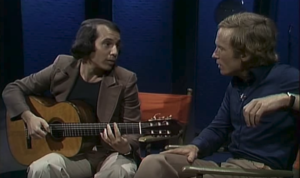I recently saw this video of Paul Simon on the “Dick Cavett Show” performing a partially finished “Still Crazy After All These Years.” You can listen to the completed version here. There’s three lessons in this video – it’s okay to ask for help, give your audience a chance to be an insider and show your process.
It’s okay to ask for help
The first lesson is there’s power in showing off the start of your project and saying, “Here’s what I have. What are your ideas for this?” If Simon had been sitting with another musician they may have been able to finish the song together. It may have ended up being different than what Simon ended up with. It’s most likely that would have happened.
The nice thing about asking for help is that it’s a chance for other ideas, other thoughts, to enhance your project to make it grow and take it in different directions. It gives you, and your project, a different perspective. Someone’s idea can trigger another idea. Ideas feed off of other ideas. Suddenly, it’s a completely different form. Don’t miss out on showing your works in progress, ask for help and see where others can take it. Whenever I share something with others it always ends up better.
A chance to be insider
Second, what Simon does by unveiling the half-finished song is it offers the audience a glimpse into his world. It makes us feel like he’s letting us in to a secret place that isn’t reserved for just anyone. With social media it’s easier to do this today. You can offer anyone a glimpse into your world. Take them into areas that are normally off limits. It’s a great way to build a strong connection with someone. You feel closer to them, like you’re part of an exclusive club. Austin Kleon is really good at this.
An example of this is when I saw the Bangles in concert. They played two new songs during the show that hadn’t been released yet. You better believe I remembered those songs when they released their next album. I felt privileged that they played those songs for me (along with the rest of the audience) that night.
Showing the process
The third lesson is at times the most mysterious. I’m interested in creative people’s processes. After taking in someone’s work I’ll ask myself, “How’d they do that?” After Simon stops playing he offers some choices of where he could go with the song. He shows you how he thinks, what his thought process is.
Since it’s rare to see the creative process it’s especially helpful to take a look when we can. Usually we get to see the finished piece of work, but not how it evolved into its final form. I love The Beatles Recording Sessions by Mark Lewisohn and also The Making of Pump by Aerosmith. It’s a look into the process of two of music’s most successful bands. I love learning about how the tracks were made, how they did it, and with the Aerosmith video where they took a phrase or riff.
It’s noteworthy, that almost all DVDs have these types of insights. I encourage you to take advantage of them. Watch the movie with the director’s commentary. Watch the film with the script on half of the screen. It’s a great way to see what’s written versus what was captured on film. And if there is a difference you can see, why does it vary from the script? Should the deleted scenes have been kept? Why do you think they were edited out? We can learn from other people’s processes. Dive in.
How do you ask for help to make your work better? Do you let your audience in on your work? What are your processes?

Speak Your Mind